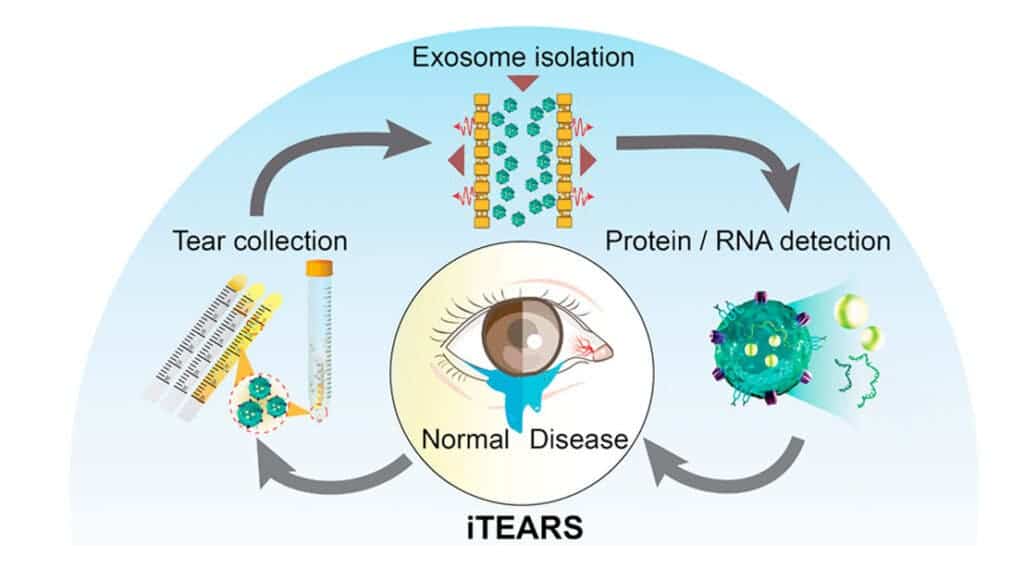
Some people dread going to the doctor so much that they could cry. Well, you might actually be encouraged to during an appointment sometime in the future. Researchers have devised a nanomembrane system that analyzes extracellular vesicles called exosomes found in human tears and looks for signs of potential diseases. It’s a noninvasive solution that could provide reliable medical diagnosis for a number of eye-related conditions, but also other conditions that may affect other parts of the body, not just the eyes.
“Through our eyes, we can see, feel, and make communications. Our tears usually maintain ocular health, reflect our body conditions, and express emotions. In this work, we expect to provide a new way to discover the secret of diseases and reflect emotions from tear extracellular vesicles combined with proteomics and sequencing technologies. We are interested in investigating extracellular vesicle-based multi-biomarkers from drops of tears for clinical diagnostics. Since the lacrimal glands secrete tears in the eyelids through filtration from blood plasma, which circulates the entire body by collecting exosomes from organs and tissues, it is time to recognize that tears contain rich clinical information about different parts of our body,” lead authors Dr. Luke P. Lee from the Harvard Medical School and Dr. Fei Liu from the Wenzhou Medical University told ZME Science.

Exosomes carry nucleic acids, proteins, lipids, and metabolites, components that can not only reflect their cell of origin but also offer a means to detect diseases. They are released from many cell types, such as dendritic cells (DCs), lymphocytes, platelets, mast cells, epithelial cells, endothelial cells, and neurons, and can be found in most bodily fluids including blood, urine, saliva, amniotic fluid, breast milk, and — as you now know — tears.
Until not too long ago, exosomes were thought to serve simply as “garbage bags” for cells to dump their unwanted constituents. However, recent research has shown that exosomes aren’t just some biological bins, but rather play an important role in cell-to-cell communication and influence both physiological and pathological processes. These properties make exosomes ideal for diagnostics. For instance, exosomes may contain nucleic acids and proteins linked to cancer, as well as neurodegenerative, metabolic, infectious, and other diseases.
The new system, dubbed “Incorporated Tear Exosomes Analysis via Rapid-isolation System,” or simply iTEARS for short, can separate exosomes from tear samples in just five minutes, as opposed to the hours or even days required by traditional approaches, such as ultracentrifugation (UC) and size exclusion chromatography (SEC), which involve complicated multi-step processes and require large sample volumes.
The secret to these quick readouts lies in a nanoporous membrane with oscillating pressure flow that effectively reduces clogging. The system allowed the researchers to tag proteins with fluorescent probes for tracking and later transfer to other instruments for further analysis, as well as extract nucleic acids for analysis.
“Using our established method, 18.4-fold and 2.3-fold elevation in particle amounts could be found compared with UC and SEC, respectively. Our approach shows a fast-processing time (under 5 minutes) and high recovered yield with a relatively high purity, which allows us to obtain more proteins and miRNAs through the tear-extracellular vesicles per drop than in urine or blood and reach the aim for tear-exosome-based precision medicine (i.e., molecular diagnosis),” the researchers told us in an email.
In a demonstration, using iTEARS, the researchers were able to identify dry eye disease and diabetic retinopathy in samples taken from healthy controls and patients. But tears could be used to diagnose a range of diseases that affect the body, not just the eyes, the researchers claim. Along with blood and urine, tears could thus become viable samples that doctors could take in order to perform non-invasive and fast diagnoses or track disease progression.
“The previous reports have also demonstrated the relationship of tear components with body organs such as the brain and breast. Studies based on tear samples are limited compared to other body fluids (e.g., urine and blood). However, tears are relatively pure with low potential contaminant interference, directly correlated with circulating fluids such as blood. The collection of tear samples is fast and noninvasive, which attracts great attention in point-of-care studies.”
Next, the researchers plan on using iTEARS to explore a range of disease diagnoses. They also want to see whether iTEARS can be used to spot signs of stress and other markers of mental health problems.
“We hope to provide a clinical translation method for tear-based molecular diagnostics and prognostics not only the eye-related diseases, but also for cancers, diabetes mellitus, neurologic diseases, and the biological functions of emotional tears.”
The findings appeared in the journal ACS Nano.


